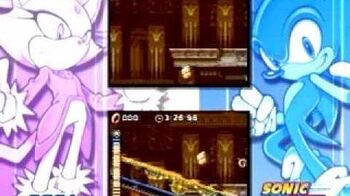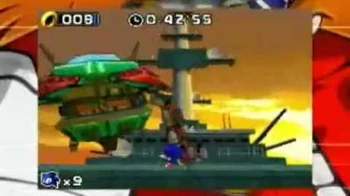No edit summary Tag: sourceedit |
Tags: Visual edit apiedit |
||
| Line 152: | Line 152: | ||
**[[1-Up]] |
**[[1-Up]] |
||
**[[Attract]] (Battle Play only) |
**[[Attract]] (Battle Play only) |
||
| − | **[[Shield |
+ | **[[Shield]] |
**[[Confusion]] (Battle Play only) |
**[[Confusion]] (Battle Play only) |
||
| − | **[[Invincibility |
+ | **[[Invincibility]] |
| − | **[[ |
+ | **[[Lightning Shield]] |
**[[Max Tension Bonus]] |
**[[Max Tension Bonus]] |
||
**[[Super Ring|Random Ring Bonus]]* (Battle Play only) |
**[[Super Ring|Random Ring Bonus]]* (Battle Play only) |
||
| Line 272: | Line 272: | ||
*[[Egg Hammer Fortress]] |
*[[Egg Hammer Fortress]] |
||
*[[Egg Eagle]] |
*[[Egg Eagle]] |
||
| − | *[[Dead Line boss (Sonic/Blaze) |
+ | *[[Dead Line boss (Sonic/Blaze)]] |
*[[Egg King]] |
*[[Egg King]] |
||
*[[Egg Salamander]] |
*[[Egg Salamander]] |
||
| Line 337: | Line 337: | ||
===Options=== |
===Options=== |
||
| − | '''Options''' is the settings menu for ''Sonic Rush''. It should be noted that the Language Settings for the game can only be done via the Nintendo DS's Menu Screen before starting the game.<ref>''Sonic Rush'' ([[Nintendo DS]]) United States instruction manual, p. 15.</ref> The following options are: |
+ | '''Options''' is the settings menu for ''Sonic Rush''. It should be noted that the Language Settings for the game can only be done via the Nintendo DS's Menu Screen (or if using the [[Nintendo 3DS]], through '''System Settings''') before starting the game.<ref>''Sonic Rush'' ([[Nintendo DS]]) United States instruction manual, p. 15.</ref> The following options are: |
*'''Player Data''': Views the player's name and the records of their performances in Battle Play and Time Attack. |
*'''Player Data''': Views the player's name and the records of their performances in Battle Play and Time Attack. |
||
*'''Difficulty''': Changes the difficulty level of the game. There are two levels, "Normal" and "Easy" (Easy mode lowers the hit points of bosses from eight to six). |
*'''Difficulty''': Changes the difficulty level of the game. There are two levels, "Normal" and "Easy" (Easy mode lowers the hit points of bosses from eight to six). |
||
| − | *'''Time Limit''': |
+ | *'''Time Limit''': Set to ON to let the time run out to ten minutes to give a Time Over. However, when this happens, the player does not lose a life. |
*'''[[Sound Test]]''': Listen to the various music tracks and sound effects used in the game. Becomes available áfter clearing the main Gameplay Mode as [[Sonic the Hedgehog|Sonic]] or [[Blaze the Cat|Blaze]]. Tracks 110-127 become available after clearing [[Exception]]. |
*'''[[Sound Test]]''': Listen to the various music tracks and sound effects used in the game. Becomes available áfter clearing the main Gameplay Mode as [[Sonic the Hedgehog|Sonic]] or [[Blaze the Cat|Blaze]]. Tracks 110-127 become available after clearing [[Exception]]. |
||
| − | *'''Delete Save Data''': |
+ | *'''Delete Save Data''': Deletes the main game's save file. After doing this, the player returns to the title screen. |
*'''Download Demo''': Allows other players to download a Demo version of the game by using the [[Nintendo DS]]'s Wireless Communication feature. |
*'''Download Demo''': Allows other players to download a Demo version of the game by using the [[Nintendo DS]]'s Wireless Communication feature. |
||
| Line 366: | Line 366: | ||
==Trivia== |
==Trivia== |
||
| − | *There is a |
+ | *There is a typo on the back of the box of ''Sonic Rush'': "Includes wireless play and new a [''sic''] mysterious female companion created exclusively for Sonic Rush!". It is supposed to read "''a new'' mysterious female companion". |
*This is the first ''Sonic'' handheld game to feature the [[4Kids Entertainment|4Kids]] actors who previously did voice-work for the anime ''[[Sonic X]]''. |
*This is the first ''Sonic'' handheld game to feature the [[4Kids Entertainment|4Kids]] actors who previously did voice-work for the anime ''[[Sonic X]]''. |
||
*This game marks the debut of [[Blaze the Cat]] and her [[Burning Blaze]] transformation, as well the recurring villain [[Doctor Eggman Nega|Dr. Eggman Nega]]. |
*This game marks the debut of [[Blaze the Cat]] and her [[Burning Blaze]] transformation, as well the recurring villain [[Doctor Eggman Nega|Dr. Eggman Nega]]. |
||
| Line 375: | Line 375: | ||
*In the Japanese version of the game, Sonic's vocal work is in English. |
*In the Japanese version of the game, Sonic's vocal work is in English. |
||
*This game marks the introduction of the [[Sonic Boost]] which would become a stable in [[Sonic the Hedgehog]]'s moveset in the following titles.' |
*This game marks the introduction of the [[Sonic Boost]] which would become a stable in [[Sonic the Hedgehog]]'s moveset in the following titles.' |
||
| − | *[[Water Palace]], one of the [[Zone]]s in ''Sonic Rush'' is represented as an [[Water Palace (Sonic Generations)|playable Stage]] in the |
+ | *[[Water Palace]], one of the [[Zone]]s in ''Sonic Rush'' is represented as an [[Water Palace (Sonic Generations)|playable Stage]] in the Nintendo 3DS version of ''[[Sonic Generations]]''. |
==Videos== |
==Videos== |
||
Revision as of 21:54, 30 December 2016
Sonic Rush (ソニック・ラッシュ Sonikku Rasshu?) is a platform handheld video game in the Sonic the Hedgehog series for the Nintendo DS. The game was released on November 2005 and was developed by Dimps and Sonic Team. The game capitalizes on the 'dual screen' aspect of the Nintendo DS in multiple ways, utilizing two screens as one extended vertical screen for very steep climbs and drops. Sonic Rush centers around two parallel universes colliding, featuring Sonic the Hedgehog and a new character, Blaze the Cat. They respectively battle Dr. Eggman and a new foe named Dr. Eggman Nega.
Designed as a 2.5D side-scroller, Sonic Rush is the first game in the Sonic series to explore both 2D and 3D venues by combining two-dimensional environments with three-dimensional models. In 2007, the game received a sequel, Sonic Rush Adventure.
Development
Before Sonic Rush was released, a short demo, Sonic E3 Demo, was developed. The gameplay involved rubbing the DS's touch screen to make Sonic run along a predetermined path and trying to complete a simple race course. The demo was rendered in 3D, but only one level could be played. After the demo was finished, Sonic Team began work on Sonic Rush.
Sonic Rush playable at Tokyo Game Show before its release.
The game's 2.5D format was based on Sonic Team's idea to combine elements from 2D and 3D games in the series. Developer Akinori Nishiyama said that "for [the] Sonic DS title, we wanted to keep the elements from 2D, yet still explore some of the new elements from 3D. So we wanted to try to find a way to somehow marry both elements from 2D and 3D."[1] At TGS 2005, he stated that while working on Sonic Advance 3, he realized that the series was becoming more complicated, opting for a "fast, dynamic action" approach to the next title in the series.[2]
At E3 2004, Yuji Naka, Sega's executive managing director, announced the game.[3] A demo of the newly titled Sonic Rush was featured at E3 2005,[4] and won video game publication IGN's "Biggest Surprise" award.[5] Blaze the Cat, a new character, was revealed at Tokyo Game Show (TGS) 2005.[4] After the release of Sonic Rush, a sequel, Sonic Rush Adventure, was developed and released on 18 September 2007.
Music
The music of Sonic Rush was written by acclaimed Sega composer Hideki Naganuma. It was released in Japan as a CD, Sonic Rush Original Groove Rush, on 23 November 2005 through Wavemaster Studios. The CD has 45 tracks, seven of which are digital remixes rather than master tracks. There are two pieces of music for each zone, one for when Sonic is running through the zone and another for when Blaze is running through it. There is also a Sound Test feature where one can listen to the tracks, level BGM and character voice recordings.
Plot
- For the scripts of the storylines, see Sonic Rush/Script (Sonic), Sonic Rush/Script (Blaze) and Sonic Rush/Script (Extra).
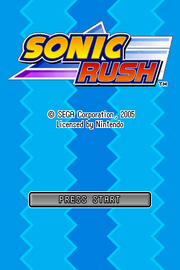
Title screen of Sonic Rush.
At the beginning of the story, Blaze the Cat, an antisocial princess from an alternate dimension, appears on Sonic's world. Her world had the seven Sol Emeralds—gems similar to the Chaos Emeralds—which it relies on for survival. However, they were stolen by Dr. Eggman and as Blaze was chasing him, a light brought her to this world. Blaze then makes it her goal to personally retrieve the Emeralds from Eggman. Upon finding Eggman, the doctor flaunts a Sol Emerald, stating that he needs them to access ultimate power. Enraged, Blaze defeats Eggman and regains the Emerald. Though Eggman escapes, Blaze is determined to get the rest.
Confused and alone, Blaze ponders how she will get the Sol Emeralds back, and how to return home. She soon spots Cream the Rabbit and Cheese hiding in the bushes, and is surprised by Cream's politeness, the young rabbit eager to make friends with Blaze. Brought to Cream's home for a cup of tea, Vanilla and Cream convince Blaze to have the latter be her local guide after hearing her story. However, Blaze dismisses their advice to seek Sonic's aid, believing she can do this alone. Despite having Cream tag along, Blaze remains mostly indifferent to the young rabbit's efforts to be her friend.
Elsewhere, Sonic encounters Eggman during a run, who boasts about how he will soon have ultimate power. Upon defeating Eggman, Sonic finds a Sol Emerald that Eggman dropped, at which point Blaze appears and reclaims it, thanking Sonic for defeating Eggman before leaving. Confused, Sonic teams up with Tails to figure out what is going on while collecting the Chaos Emeralds.
Eventually, Sonic comes across a new foe—an Eggman-lookalike named Dr. Eggman Nega, who is bend on domination as well. After defeating him, Tails discoveres that the space-time continuum has been torn due to the Sol Emeralds residing in Sonic's dimension, resulting in a slow merging of both Sonic and Blaze's worlds which could spell doom for them all. Sonic grows suspicious of Blaze's alliance, and along with Tails, looks for her. Along their adventures, both Sonic and Blaze come across Knuckles and Amy. Blaze in particular starts to ponders who Sonic really is, as everyone she meets mentions Sonic in one way or another.
Eventually, Sonic and Tails find Blaze and Cream. Sonic questions Blaze about her nature, but she does not give any information, because she says it is her responsibility, and leaves with Cream. Not keen on letting Blaze do this alone, Sonic and Tails follow her. While Sonic chases her, Blaze starts to soften up to Cream and begins to experience friendship for the first time, something which she allowed herself due to her strict disciplin.
Sonic ends up following Blaze to Dead Line, where it is revealed that Eggman and Eggman Nega are working together to collect both the Chaos Emeralds and the Sol Emeralds. Blaze declares that she will destroy both Eggmans and save both worlds on her own. When Sonic once again questions her intentions, she fights him, believing Sonic is getting in the way of her duty. During their fight, Blaze reveals how her powers and duty "cursed" her to a life of solitude, which is why she has to be alone. After a final clash, Sonic makes Blaze see the value on having others to rely on and Blaze realizes the error of her ways. In the aftermath, Eggman kidnaps Cream, but Blaze goes after him while Sonic takes on Eggman Nega. After their fights, Blaze reunites with Cream, whom Blaze finally acknowledges as her friend. Meanwhile, Sonic watches their victory with a smile, but is alerted to a smitten Amy coming towards him, prompting Sonic to run away from her.
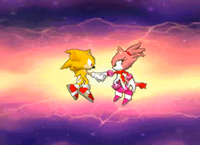
Sonic and Blaze parting ways with a handshake.
After Sonic and Blaze have collected all the Chaos Emeralds and Sol Emeralds, Blaze has her Emeralds stolen from her by Eggman and Eggman Nega, who drain the Sol Emeralds of their power. Sonic then meets up with Blaze, who despairs over failing to restore balance between the two worlds. However, Sonic and his friends help Blaze realize the meaning of friendship, which in turn recharges the Sol Emeralds and turns her into Burning Blaze. With Sonic using the Chaos Emeralds to transform as well, Super Sonic and Burning Blaze confront the Eggmans and defeats them, foiling their plans to build an Eggmanland and dominate both dimensions. As their worlds are restored, Sonic and Blaze chat about how they and their friends will miss one another. Blaze says it is best she leaves like this, but thanks Sonic for his help. Before Blaze leaves, Sonic promises her that they will meet again and the two shake hands just before their dimensions pull them back to their worlds. Back home, Blaze realizes that carrying the world's weight on her own shoulders could lead to irresponsibility, and so she vows to live life with a more open heart. Back on Sonic's world, Cream is crying because she misses Blaze, but Sonic cheers her up by telling her that Blaze promised to return someday.
Gameplay
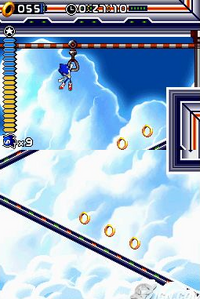
Sonic in a Zone in Sonic Rush, demonstrating the dual-screen feature.
Sonic Rush is a 2D platformer game, similar to earlier games in the series as well as later ones like Sonic Advance. The player controls either Sonic the Hedgehog or Blaze the Cat (Blaze becomes playable after defeating the Egg Hammer Mega in Sonic's story). Each character may differ in terms of abilities, but share otherwise similar moves for exploration and combat. In the tradition of past Sonic games, the goal is to reach the end of each Act of a Zone (a level in the game) in ten minutes. During regular Acts, both of the Nintendo DS's screens are used to display the area, with the playable characters moving between them when they reach certain heights or depths. After clearing the Boss Act, the progress is saved automatically and the player can proceed to the next Zone.
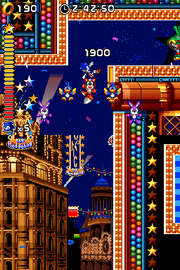
Sonic performing Advanced Trick Actions.
A new feature introduced in Sonic Rush is the "Tension Gauge" mechanic. The energy it generates allows the player to use the Super Boost and Fire Boost for Sonic and Blaze respectively, new abilities debuting in this game which give them a boost in speed while moving and lets them plow through enemies and obstacles without harm. When overcharged, the Tension Gauge has unlimited energy for a short time. The Tension Gauge is filled by performing Trick Actions, defeating enemies, passing Checkpoints and certain power-ups. The first method is an expansion of the Mid-Air Trick Actions introduced in Sonic Advance 2, and allows the playable characters to pulls off acrobatic stunts on Grind Rails or when sent flying into midair by gimmicks like Springs or Ramps. Performs such trick combos lets the player rank up energy for the Tension Gauge and points. Certain tricks also enable wider aerial movements. However, they will fail if interrupted.
Sonic Rush also introduces the Ranking system from the console Sonic titles on the handheld for the first time. After completing an Act, the player receives a rank (C being the lowest and S being the highest) based on the total Time, Trick, Ring and Speed Bonuses in the Act.
The player can collect Rings as a form of health. Like the traditional Rings, they give an extra life after collecting 100 of them, award points, and protect the player from damage. When taking damage, the player will drop all their Rings. However, a unique mechanic in this game compared to previous 2D games is that the more the player gets hit, the further the Rings will scatter. Taking damage without any Rings at all will cost the player a life. The player will also lose a life if the playable character spends too long underwater without replenishing their air supply (air underwater lasts for 18 seconds), falls into a bottomless pit, gets crushed or runs out of time. Losing a life makes the player start from the last Checkpoint they passed, or from the beginning of the Act if they have not passed any Checkpoints. If a character loses a life when the number of tries remaining is zero, the game is over. Aside from Rings, Sonic Rush also features Item Boxes and their balloon variants which contain the classical power-ups. The game introduces as well the Tension Bonus and Max Tension Bonus power-ups which can fill up the Tension Gauge.
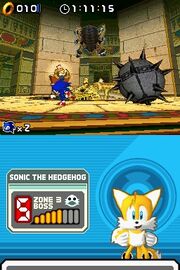
Sonic fighting the Egg Scarab. All boss battles in the game utilize 3D-rendered graphics.
Although Sonic Rush is primarily two-dimensional, it also incorporates three-dimensional elements to create a 2.5D effect. This is presented in the Acts focusing on 2D side-scrolling action with multiple sections containing gimmicks rendered in 3D, along with Sonic and Blaze's having 3D models as well. Each Zone's Boss Act is also entirely 3D, where Blaze fights Dr. Eggman and Sonic fights Eggman's doppelganger Eggman Nega. The game features as well Special Stages in 3D exclusive to Sonic which he can access via Special Generators in order to obtain the Chaos Emeralds.
As the characters' stories progress, they meet each other several times and unite in the final Zone that comes after the seventh. Noticeably, Blaze earns Sol Emeralds throughout her story's default Boss Acts, unlike Sonic and the Chaos Emeralds. To unlock the final Zone in the game, the player must collect the seven Chaos Emeralds and clear both Sonic and Blaze's stories.
Controls
Character movesets
| Button formation | Movement | |
|---|---|---|
| Walk/Run & Brake | ||
| Look up, crouch & scroll screen | ||
| START | Pauses the game. | |
| Spin Jump | Axel Jump | |
| Spin Dash | Burst Dash | |
| Spin Attack | Burst Dash | |
| Jump Dash Homing Attack* (Near an enemy) |
Burst Hover | |
| Super Boost* | Fire Boost* | |
| Basic Tricks/Advanced Tricks* | ||
| Grind Tricks* (On Grind Rails) | ||
| Just Trick* (At the end of Grind Rails, Springs or Ramps) | ||
| Hop Jump* | Axel Tornado* | |
| Humming Top* | Jump Step* | |
* Cannot be performed in Boss Acts.
Other moves
- Grinding: A technique where the characters automatically slide down a Grind Rail they stand on. The player has to land on the rail to grind on it and jump to get off it.
- Boost Mode: A technique that enables the characters to run at maximum speed. The player has to either run at top speed for a few seconds or use gimmicks like the Dash Panel or horizontal Springs to enter the Boost Mode.
Items
- Rings
- Item Boxes (Normal & floating types)
- 1-Up
- Attract (Battle Play only)
- Shield
- Confusion (Battle Play only)
- Invincibility
- Lightning Shield
- Max Tension Bonus
- Random Ring Bonus* (Battle Play only)
- Ring Bonus (5, ?*)
- Slow (Battle Play only)
- Tension Bonus
- Checkpoint
* Ring Bonuses with question marks grant randomly 1, 5, 10, 30, or 50 Rings.
Gimmicks and obstacles
|
|
Characters

The majority of the protagonists in Sonic Rush.
Playable characters
Non-playable characters
- Dr. Eggman
- Dr. Eggman Nega
- Miles "Tails" Prower
- Cream the Rabbit & Cheese
- Amy Rose
- Knuckles the Echidna
- Vanilla the Rabbit
- Chao (cameo)
Animals
Enemies
Bosses
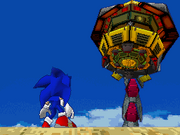
- Egg Hammer Mega
- Egg Turtle
- Egg Scarab
- Egg Libra
- Egg Hammer Fortress
- Egg Eagle
- Dead Line boss (Sonic/Blaze)
- Egg King
- Egg Salamander
Zones
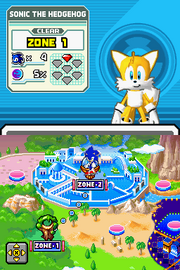
The Zone Map displaying the player's progress and the locations of Zones.
Sonic Rush consists of nine Zones, most of which are split into two Acts with a Boss Act at the end. The course of the game depends on the player's choice between Sonic and Blaze; the player will go through the same Zones, but in different orders according to the character. The ninth Zone becomes available after getting all the Chaos Emeralds and clearing both Sonic's and Blaze's stories.
The player moves between Zones on the Zone Map. The Top Screen shows the player's progress and the Touch Screen displays the player's position. Pressing ![]() lets the player view further sections of the map and
lets the player view further sections of the map and ![]() exits this feature. Pressing START gives the player the option of returning to the title screen. The player can also utilize the Nintendo DS stylus controls to tap on a Zone icon to move towards it. If the player has already cleared the Zone's Boss Act, they can replay any of its Acts upon selecting it.
exits this feature. Pressing START gives the player the option of returning to the title screen. The player can also utilize the Nintendo DS stylus controls to tap on a Zone icon to move towards it. If the player has already cleared the Zone's Boss Act, they can replay any of its Acts upon selecting it.
All Zones in Sonic Rush are listed for each playable character in the following order:
Special Stages
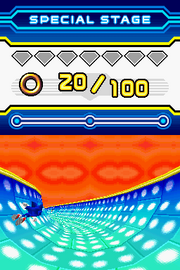
Sonic in the first Special Stage.
In Sonic's story, each Zone has Special Generators in different places. By swinging around on this gimmick with the Super Boost long enough, the player will enter one of seven Special Stages. Each Special Stage can only be entered via their Zone's Special Generator.
Special Stages in Sonic Rush involve the player running down a three-dimensional half-pipe route (akin to the Special Stages in Sonic the Hedgehog 2). The goal is to collect the requisite amount of Rings before hitting the next Checkpoint or the Goal in order to get a Chaos Emerald. In gameplay, the player uses the Nintendo DS's stylus controls to move Sonic around the half-pipe route. Avoid Bombs and enemies, and utilize gimmicks on the route to gather extra Rings. Hitting enemies also grant a few Rings. Only one Emerald is awarded per Special Stage, so the same Stage cannot be repeated for multiple Emeralds.
Other modes
Battle Play
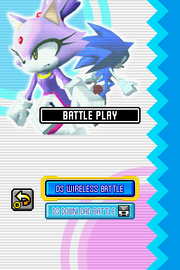
Battle Play menu.
Battle Play is the main multiplayer component of Sonic Rush, allowing gaming between two players. Two Nintendo DS handheld consoles are required for Battle Play and one or both players must have the Sonic Rush cartridge. There are two ways to access Battle Play: Single-Card Play or Multi-Card Play. These options do not impact the gameplay.
- DS Wireless Battle: Play the game with Multi-Card Play. One player (Player 1) has to create a "room" for the other player (Player 2), who must join it after its creation. Choosing the Multi-Card Play saves time to set up the game.[6]
- DS Download Battle: Play the game with Single-Card Play. This option automatically create a "room" for the participants. Players have to download the game using the Nintendo DS Wireless Communications feature and pick up "SONIC RUSH" (Player 1) or "SONIC RUSH (BATTLE)" (Player 2) to enter Battle Play.
In Battle Play, two players play as Sonic and Blaze in one of the game's Acts. However, the same character cannot be used by both players, and the only Zones/Acts that can be selected are those completed in the Gameplay Mode by either player. The goal is simply to race to the Goal Ring at the end of the Act. The first player to reach it wins. If players do not reach the goal before the time limit expires, the game ends in a draw.
Along the way, players can attack each other to briefly stun them (without causing loss of Rings) or use the Item Box power-ups Attract, Confusion, Max Tension Bonus, Random Ring Bonus and Slow to obstruct each other. Along with the standard data, the game's HUD also shows the player's position during the race. While lives are not use in Battle Play, players are still sent back to the latest Checkpoint or the beginning whenever they fall into a situation where they would lose a life in the Gameplay Mode.
During gameplay, the Nintendo DS's Top Screen shows the playable character, while the Touch Screen only shows the player and opponent in form of icons. Pressing SELECT will switch these displays.
Time Attack
Time Attack allows players to replay previously cleared Acts and bosses with the goal of getting the fastest record possible. The top five records will be saved for each Act. Time Attack becomes available after clearing the Gameplay Mode either as Sonic or Blaze.
Options
Options is the settings menu for Sonic Rush. It should be noted that the Language Settings for the game can only be done via the Nintendo DS's Menu Screen (or if using the Nintendo 3DS, through System Settings) before starting the game.[7] The following options are:
- Player Data: Views the player's name and the records of their performances in Battle Play and Time Attack.
- Difficulty: Changes the difficulty level of the game. There are two levels, "Normal" and "Easy" (Easy mode lowers the hit points of bosses from eight to six).
- Time Limit: Set to ON to let the time run out to ten minutes to give a Time Over. However, when this happens, the player does not lose a life.
- Sound Test: Listen to the various music tracks and sound effects used in the game. Becomes available áfter clearing the main Gameplay Mode as Sonic or Blaze. Tracks 110-127 become available after clearing Exception.
- Delete Save Data: Deletes the main game's save file. After doing this, the player returns to the title screen.
- Download Demo: Allows other players to download a Demo version of the game by using the Nintendo DS's Wireless Communication feature.
Reception
| Reception | |
|---|---|
| Aggregate scores | |
| Aggregator | Score |
| GameRankings | 83%[8] |
| Metacritic | 82%[9] |
| Review scores | |
| Publication | Score |
| 1Up.com | B+[10] |
| GamePro | 3.5/5[11] |
| GameSpot | 8.2/10[12] |
| GameSpy | 3.5/5[13] |
| IGN | 9/10[14] |
| Nintendo Power | 9.0[15] |
Sonic Rush was released on November 15, 2005 in North America; November 18 in Europe; and November 23 in Japan.[16] It was the ninth best-selling DS game of December 2006.[17] It sold approximately 360,000 copies in Europe, making it Sega's fourth best-selling game during the third quarter of its fiscal year ending March 2007.[18] The game was released to positive reviews, with a Game Rankings score of 83%[8] and a Metacritic score of 82%.[9] Critics praised the game for its usage of elements from older Sonic games. Gamespot, IGN, and Nintendo Power compared the game to older games in the series, specifically those on the Sega Genesis.[12][14][15] GameSpy staff writer Greg Sewart offered a similar opinion, also praising the game for its "gorgeous graphics".[13] The game's overall quickness was not as well received. GameSpy's Greg Sewart, although giving a mostly positive review, complained that "it's so fast you almost can't tell what's going on most of the time."[13] 1UP.com and GamePro thought similarly.[10][11] The game's music was well-received, called "bright [and] buoyant" by 1UP.com and compared to that of Jet Set Radio by GameSpot.[12] GameSpy called the music "all very fitting and very catchy", noting its use of sampling and unconventional structure.[10] Official Nintendo Magazine scored the game with 92%, along stating to be "The Best Sonic Game Ever!"[19]
In 2008, Sonic Rush was listed at #17 in IGN's list of the top 25 DS games.[20] On September 11, 2009, it was listed as one of the "cheers" on IGN's "Cheers & Tears" list of action games for the DS.[21]
Re-releases
In 2009, Sega re-released Sonic Rush along with another Sega game, Super Monkey Ball Touch and Roll, in the compilation title Sega Fun Pack: Sonic Rush & Super Monkey Ball: Touch & Roll.
Trivia
- There is a typo on the back of the box of Sonic Rush: "Includes wireless play and new a [sic] mysterious female companion created exclusively for Sonic Rush!". It is supposed to read "a new mysterious female companion".
- This is the first Sonic handheld game to feature the 4Kids actors who previously did voice-work for the anime Sonic X.
- This game marks the debut of Blaze the Cat and her Burning Blaze transformation, as well the recurring villain Dr. Eggman Nega.
- Ryan Drummond was originally going to be voicing Sonic in this game, as voice clips of his voice were heard in the E3 demo build.
- This is the first Sonic game for the Nintendo DS and for a seventh generation video game console.
- If the player taps the character during gameplay on the Touch Screen, the character will do strange movements. Sonic will turn to the player and do stretches, while Blaze will jump like a scared cat, then turn her back at the player, tapping her foot. This also happens in Sonic Rush Adventure and Sonic Colors.
- In the final cutscene of the game where Blaze returns to her dimension, the color of the skies appears green. However, in the sequel, Sonic Rush Adventure, its color is sky blue. It could be possible that she entered her world at a high altitude or that it was just either sunrise or sunset (or she might have been flying through Sky Babylon to her world, as the sky is green). Another possibility is that the green sky seen in the end of Sonic Rush was used only to emphasize the differences Blaze's world may have from Sonic's world, but was later mostly abandoned in favor of a blue sky in the game's sequel Sonic Rush Adventure.
- In the Japanese version of the game, Sonic's vocal work is in English.
- This game marks the introduction of the Sonic Boost which would become a stable in Sonic the Hedgehog's moveset in the following titles.'
- Water Palace, one of the Zones in Sonic Rush is represented as an playable Stage in the Nintendo 3DS version of Sonic Generations.
Videos
References
- ↑ GameSpot Video: Sonic Rush Developer Interview 1 (September 12, 2005). Retrieved on February 21, 2009.
- ↑ Nintendo Power (V198): 17. December 2005.
- ↑ Adams, David (May 11, 2004). E3 2004: SEGA Announces DS Titles. IGN. Retrieved on December 3, 2009.
- ↑ 4.0 4.1 Gerstmann, Jeff (September 18, 2005). TGS 2005: Sonic Rush Hands-On. GameSpot. Retrieved on December 3, 2005.
- ↑ Harris, Craig (May 27, 2005). DS Best of E3 2005 Awards. IGN. Retrieved on December 3, 2009.
- ↑ Sonic Rush (Nintendo DS) United States instruction manual, p. 27.
- ↑ Sonic Rush (Nintendo DS) United States instruction manual, p. 15.
- ↑ 8.0 8.1 Sonic Rush Reviews. Game Rankings. Retrieved on April 13, 2008.
- ↑ 9.0 9.1 Sonic Rush (ds: 2005): Reviews:. Metacritic. Retrieved on April 13, 2008.
- ↑ 10.0 10.1 10.2 Sonic Rush Nintendo DS Review Index, Sonic Rush Reviews. 1UP.com (November 16, 2005). Archived from the original on October 18, 2012. Retrieved on April 13, 2008.
- ↑ 11.0 11.1 Ouroboros (November 17, 2005). Review : Sonic Rush (DS) - from GamePro.com. Archived from the original on 2011-06-07. Retrieved on February 26, 2009.
- ↑ 12.0 12.1 12.2 Gerstmann, Jeff (November 14, 2005). Sonic Rush for DS Review - DS Sonic Rush Review. GameSpot. Archived from the original on February 3, 2006. Retrieved on February 20, 2009.
- ↑ 13.0 13.1 13.2 Sewart, Greg (November 15, 2005). GameSpy: Sonic Rush Review. GameSpy. Retrieved on February 20, 2009.
- ↑ 14.0 14.1 Harris, Craig (November 11, 2005). IGN: Sonic Rush Review. IGN.com. Retrieved on February 19, 2009.
- ↑ 15.0 15.1 Thomason, Steve (January 2006). Nintendo Power (199): 105.
- ↑ Related Games. GameSpot. Retrieved on March 31, 2010.
- ↑ Nintendo Power (210): 18. December 2006.
- ↑ Fiscal Year Ended March 2007 Full Year Results (Portable Document Format). Sega Sammy Holdings (May 14, 2007). Archived from the original on November 12, 2014. Retrieved on May 11, 2014.
- ↑ European cover art of Sonic Rush.
- ↑ IGN: The Top 25 Nintendo DS Games. IGN (October 24, 2008). Retrieved on March 3, 2009.
- ↑ Thomas, Lucas M. (September 11, 2009). Cheers & Tears: DS Action Games. IGN. Retrieved on December 23, 2009.
External links
- Official website (Japanese)
- Official website of Sonic Central
- Sonic Rush at MobyGames
- Sonic Rush at GameFAQs


